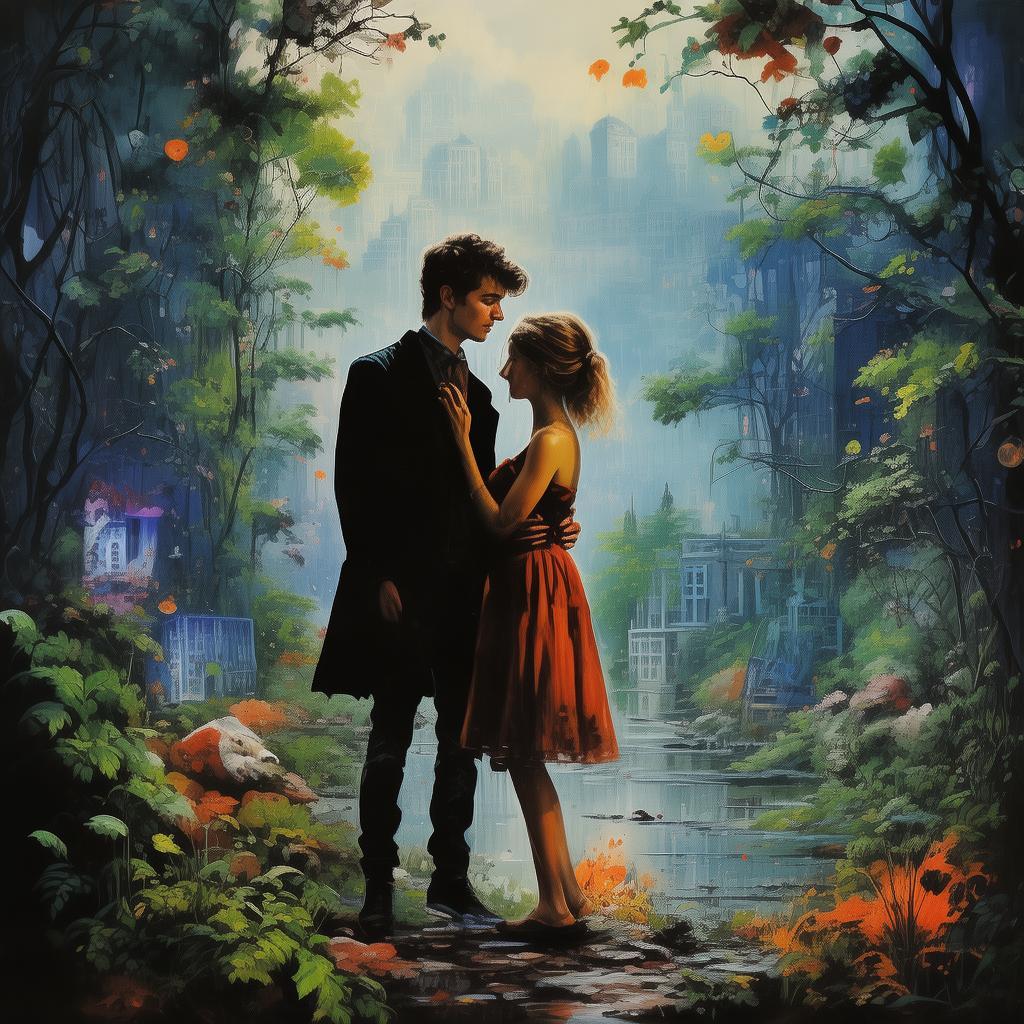The Calligrapher's Tale: A Love Conceived in Ink
In the heart of ancient Kyoto, where the streets were lined with cherry blossoms and the air was thick with the scent of blooming sakura, lived a young calligrapher named Aiko. Her hands moved with the grace of a dance, her ink flowing effortlessly across the rice paper as she crafted the most exquisite kanji and kana. Her art was a testament to her soul, and her passion was as deep as the ink that she wielded.
One rainy evening, as the city was wrapped in a shroud of gray, a mysterious letter was delivered to Aiko's workshop. The parchment was unmarked and sealed with a strange, intricate seal that seemed to beckon her to uncover its secrets. Curiosity piqued, Aiko broke the seal and pulled out the letter, its words written in an elegant, flowing script that was unlike any she had seen before.

The letter spoke of a love story, one that had been lost to time. It spoke of a man and a woman, their love as deep as the ocean, their bond as strong as the mountains. The story was written with a passion that seemed to pulse through the ink, and Aiko found herself drawn into its world, her heart racing as she read of the lovers' trials and tribulations.
As she read, Aiko felt a strange connection to the story. The woman in the letter, named Yuki, had been a calligrapher as well, and her love for the art was as fervent as Aiko's own. The man, named Takumi, was a samurai, a warrior whose life was a constant battle for honor and loyalty. Yet, it was their love that would ultimately define their destinies.
The letter spoke of a forbidden love, a love that would challenge the very fabric of society. Aiko felt the weight of this forbidden passion as she read, her own heart aching for the lovers' forbidden union. She saw the pain in their eyes, the yearning in their hearts, and she knew that this story was not just ink on paper—it was a love that lived on, even in the face of adversity.
As the days passed, Aiko became obsessed with the tale. She found herself researching the period, learning about the customs and the dangers that the lovers would have faced. She even began to create calligraphy that mirrored the style of Yuki and Takumi, her hands moving with a newfound intensity as she poured her emotions into her work.
It was during this research that Aiko discovered a clue in the letter that suggested Yuki had once lived in Kyoto, not far from where she now stood. With a heart full of hope and a mind brimming with questions, Aiko set out to find the remnants of Yuki's life, her journey taking her through the city's back alleys and ancient temples.
One evening, as she wandered through a narrow street, Aiko stumbled upon an old, abandoned teahouse. Its wooden sign, weathered and faded, whispered the name "Kagami no Sato," which translated to "Mirror's Village." The name seemed to echo with a sense of familiarity, and Aiko felt a shiver run down her spine.
Inside, the teahouse was dark and musty, the air thick with the scent of incense. As her eyes adjusted to the dim light, Aiko saw a series of mirrors lining the walls, each one etched with delicate kanji. She approached one of the mirrors and, to her astonishment, saw her reflection transformed into Yuki's face.
For a moment, Aiko was frozen in disbelief. Then, the door to the teahouse creaked open, and a figure stepped inside. It was a man, his face obscured by the shadows of the room. He approached the mirror and, as he gazed into it, his features softened, and his eyes seemed to glow with recognition.
"Yuki?" he whispered, his voice filled with wonder.
Aiko stepped forward, her heart pounding with a mix of fear and excitement. "Are you... Takumi?"
The man turned, revealing his features to be those of an old man, his hair now white with age, his eyes still sharp and intelligent. "Yes," he said, his voice a little hoarse. "I am Takumi."
The reunion between Aiko, Takumi, and Yuki was a powerful one, their love story transcending time and space. Aiko realized that the connection she felt to Yuki and Takumi was not just a fascination with their story—it was a love that had been waiting to be discovered within her own heart.
As the years passed, Aiko and Takumi became friends, their bond growing stronger with each passing day. They shared stories, laughed together, and even created their own calligraphy, their work a testament to the love that had been written in ink long ago.
But the love story was not without its challenges. Takumi's past as a samurai brought with it a sense of duty and honor that sometimes clashed with the freedom of love. Aiko, in turn, struggled with the idea that she might be living someone else's story, one that had been written in ink and time.
The climax of their love story came when a rival samurai, driven by jealousy and envy, sought to destroy the love between Aiko and Takumi. In a series of intense battles, Aiko found herself caught in the crossfire, her calligraphy becoming a symbol of her love and strength.
In the end, it was Aiko's own calligraphy that saved the day. The rival samurai, seeing the beauty and power of Aiko's work, was moved to reconsider his actions. He realized that true strength lay not in the sword, but in the heart, and in the love that Aiko and Takumi shared.
The ending of their story was a bittersweet one. Takumi, knowing that his days were numbered, decided to retire from the samurai life, and he and Aiko spent their final days traveling together, their love growing stronger with each step.
One evening, as they sat on a hill overlooking Kyoto, Takumi took Aiko's hand and looked into her eyes. "You have given me more than I ever could have imagined," he said, his voice filled with emotion. "I am a man who has lived many lives, and you have brought joy and meaning to them all."
Aiko smiled, tears streaming down her face. "And I have found my own story," she whispered, "one that is as beautiful and powerful as the ink you and Yuki wrote with."
Takumi kissed her gently, and in that moment, the love story that had begun in ink and time found its perfect ending.
✨ Original Statement ✨
All articles published on this website (including but not limited to text, images, videos, and other content) are original or authorized for reposting and are protected by relevant laws. Without the explicit written permission of this website, no individual or organization may copy, modify, repost, or use the content for commercial purposes.
If you need to quote or cooperate, please contact this site for authorization. We reserve the right to pursue legal responsibility for any unauthorized use.
Hereby declared.









